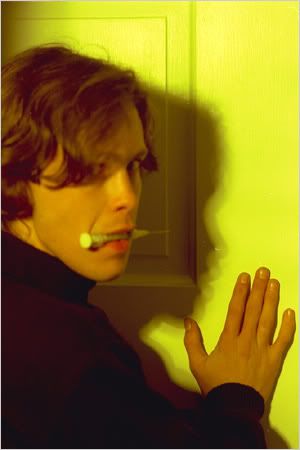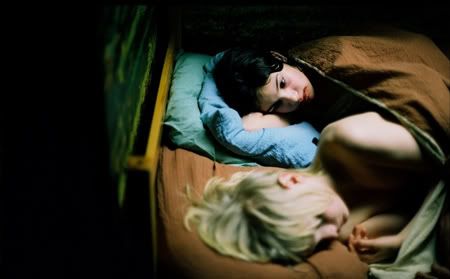Let the Right One In cuts right to the heart of this by making the vampire a pre-pubescent girl, it's almost a relief. Finally, a vampire film (with requisite gore) that is unflinchingly not about velvet-drenched sould-searching angst or eternal-youth rockstardom.
Instead, this Swedish film (based on a novel) is about a little boy, Oskar, who slowly befriends his new next-door neighbor, a strange, beautiful creature named Eli. Eli walks barefoot in the snow. Eli does not go to school. Eli lives with an older man who may or may not be related to her, but whose relationship is decidedly not parental. Oskar is bullied at school, and spends most of his time on his own, dreaming of revenge he never takes. As his relationship with Eli progresses, it becomes clear that neither of them really has anyone else, and the secret they share unites them in a world Oskar may or may not be ready to join.
The film is starkly real without sacrificing style (except for some dreadfully unfortunate CG cats I am endeavoring to forget about), and for the most part plays out like a boy-meets-girl story with periodic violence rending the silent, frozen landscape. The contrast here, both visually and thematically, is striking and effective, and it's probably the most interesting vampire movie I've ever seen.
 In many ways, while less subtly stylish, George Romero's Martin (1977) is the male companion piece to Let the Right One In. They're both about adolescence--the boy version naturally featuring an older protagonist. Martin's sexual anxiety manifests in a different way than Eli's, and his condition is ambiguous in a different way, and in the end the films are saying quite different things. But they both focus on individual (arrested) development, with vampirism as the diegetic cause of the arrest. What's unique about Martin's situation is that while he may or may not be a vampire, his reasons for thinking/pretending he is seem to be equal parts sexual (assuming his blood drinking falls into the "fetish" category) and a cry for attention (as exemplified by his anonymous late-night radio talk show calls). Martin makes the rape-fantasy aspect of the vampire myth explicit, and also explores the psychological hold the myth has on us for the simple reason that Martin is under its spell as well--whether or not he's a "real" vampire. Whatever that means.
In many ways, while less subtly stylish, George Romero's Martin (1977) is the male companion piece to Let the Right One In. They're both about adolescence--the boy version naturally featuring an older protagonist. Martin's sexual anxiety manifests in a different way than Eli's, and his condition is ambiguous in a different way, and in the end the films are saying quite different things. But they both focus on individual (arrested) development, with vampirism as the diegetic cause of the arrest. What's unique about Martin's situation is that while he may or may not be a vampire, his reasons for thinking/pretending he is seem to be equal parts sexual (assuming his blood drinking falls into the "fetish" category) and a cry for attention (as exemplified by his anonymous late-night radio talk show calls). Martin makes the rape-fantasy aspect of the vampire myth explicit, and also explores the psychological hold the myth has on us for the simple reason that Martin is under its spell as well--whether or not he's a "real" vampire. Whatever that means.Eli, by contrast, is quite certainly a vampire, though the mythos has a few surprises for us (my favorite being the consequences of entering "uninvited," one of the most effective scenes in the film). And Eli's problem is not, as we've seen before (most explicitly in the film version of Interview with the Vampire and Kirsten Dunst's dolled-up Claudia), that she's a grown up stuck in a child's body. It's that she's eternally adolescent, even if her soul is old and has witnessed things we cannot even imagine.


What's incredible about this, and what makes the explicitness of the vampire/puberty connection feel not at all overdone or cliched, is that Eli embodies qualities that could be explained by either her years of vampiric indifference to human life and gore or her developmental immaturity. She is like Oskar in her perceptions of right and wrong. Is it because her morality (that which we would call morality, anyway) has decayed, or because it never developed? She's caught eternally in the self-interest of childhood, though on the cusp enough to develop a strong attachment to a boy she sees herself in. It all seems so obvious when you think about it, but it doesn't play that way in the film, and it's refreshing to see the subject treated without kid gloves. The violence is never out of place--it's the reality of Eli's life, which is (not coincidentally) Oskar's fantasy.

Most arrested-development vampire fantasies capture the body at what many might consider its peak: the (sexually mature) teens or early twenties. For obvious reasons, since these are the sort of people we supposedly like to look at, and the stage at which we are told we should arrest our own aging process. Eli is beautiful, yes, but not the way a woman is. She moves a little awkwardly, very clearly still a girl though her prettiness makes this not a little disturbing, both in the pedophilic sense and a more thematic uncanniness. At the same time, her relationship with Oskar is troublesome in the sense that she is much, much older, but less troublesome than it might be because we get the sense that her mind as well as her body is caught at that stage. In a way, Eli can be made to represent not only our anxieties about our own pubescence and adulthood but that transition in others, and our culture's relationship to that body.
What's so compelling about Let the Right One In, along with the general quality of the filmmaking and acting, is that it doesn't shy away from any of these disturbing elements. Nor does it give us any clear answers. It creates a world, much like ours, where vampires are real but most people don't know about them, and then treats it from a child's point of view, with all the horror (and sweetness) that entails. The two children together are incredible, and the only reason I don't want to say that they transcend the words "vampire film" is because I think every horror movie should be saying something about our psychology or society. Perhaps most of them are, but few of them do so with the curious mix of overtness and restraint as this, and few offer so much food for thought.


2 comments:
Wonderful review! I loved this movie--aside from the plot, the imagery of Scandinavia (Sweden? I forget.) was starkly beautiful. The climax at the pool was incredibly shot. I strongly recommend the book if you haven't checked it out yet. Some of the fleshed-out subplots are very enlightening, and remain embedded in the film if you are watching for them.
checking out the book at some point. Thanks for your comment.
Post a Comment